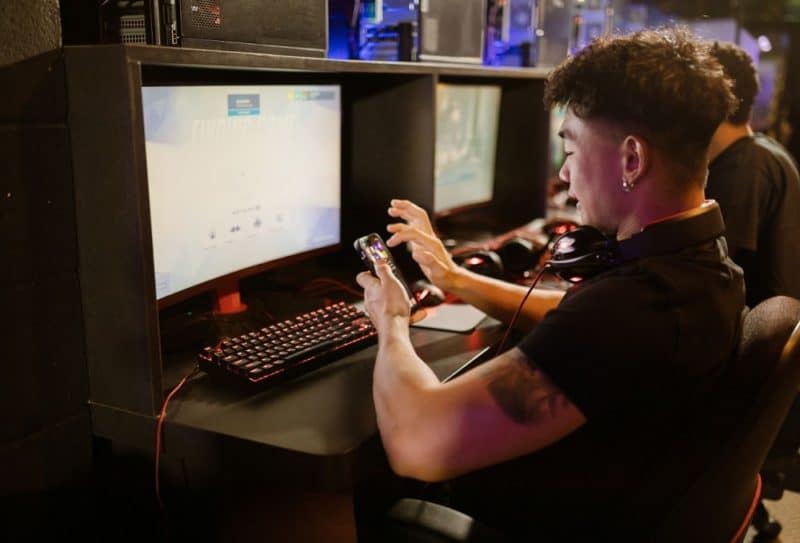How Much Input Lag Is Acceptable In Gaming?
Input lag can affect the best of us. On this page, we’re going through what input lag is, how it differs from response time, and how it affects TVs and monitors differently. Then we’ve explained how much input lag is acceptable to still maintain an enjoyable experience. We finish with tips on how to reduce input lag, too.

What Is Input Lag?
Input lag, or display lag, is where there is a delay between the frames your GPU sends to your monitor. This means that there is a slight but noticeable pause in how your monitor displays each frame. So, when you command your TV or monitor to do something through a remote controller, a keyboard, or a mouse, there will be a short, distracting delay.
If input lag gets bad enough, it’ll make gaming impossible, especially if you’re trying to play a competitive online game where you need to react quickly to the moves of other players. Every millisecond counts when you’re battling players online, so it’s easy to see why gamers pay so much attention to the input lag.
The ideal input lag is less than 15 milliseconds. You won’t typically find input lag details given by manufacturers, so you’ll need to do some research into it. Fortunately, there are many places online that test display products and find out what the input lag is, given in milliseconds.
What Is Response Time?
Many make the mistake of confusing input lag with response time, which are two different things. Unlike input lag, you will find response time speed details from monitor manufacturers and suppliers. Companies that sell TVs don’t provide response time speed information because it’s not generally considered by buyers.
Response time is the time it takes for a pixel to change from one shade to another. This happens after the frame has been processed, which is where input lag happens. Any figures related to response time is a measurement of how long it takes for a pixel to go from black to white, and then to black again. Response time is more important for color fidelity and vibrancy.
The Difference Between TV & Monitors
With input lag, there is a difference in how it affects TVs and monitors. TVs over-process the frames that they display, creating a higher input lag than monitors. If you’ve ever played with the settings of your TV, you may have seen a ‘game mode’ setting. That decreases input lag so that the TV can be used for gaming and other activities that require a quick reaction. You should look for the game mode feature on any TVs you buy for console gaming.
Since monitors keep input lag low and don’t over-process their frames, you don’t need to worry about a game mode feature. All you need to do is get a low-input lag monitor and, if the input lag becomes a problem for any reason, you should find ways to make it more manageable.
What Input Lag Is Acceptable?
As we said above, you’re doing well with an input lag that is below 15 milliseconds. Monitors should definitely be under 15 milliseconds while TVs can stretch to a maximum of 35 milliseconds. Don’t bother with a TV if its input lag is greater than 30 milliseconds.
Of course, this is all a matter of opinion and entirely depends on how quickly you want/need your display to react to your commands. Playing a slow-burn strategy game won’t demand fast display reactions in the same way an intense first-person shooter would, after all. Then there’s the fact that many people play games in single-player mode, so input lag becomes a lot less important. That said, it is generally agreed that below 15 milliseconds is good.
The threshold for noticeability is 50 milliseconds and over. That’s where your eyes start noticing that something is wrong with your display and how fast it reacts to your input. The game will become stiff and fail to respond in time. Something to keep in mind is that 25 milliseconds is approximately 1 frame. We notice when 3 frames are interfered with, which is somewhere around a 58-millisecond input delay.
Do you have a noticeable input lag? Is it interfering with your ability to play and win games online? Fortunately for you, we have some tips on reducing input lag below!
Reducing Input Lag
Sometimes you can suffer from input lag without it being tied to your display quality. Before you start questioning the input lag of your TV or your monitor, you should rule out the following possible causes.
First, make sure your TV is in its game mode if that’s what you use to game. Many of us buy TVs and then use them on their default settings. That’s fine for watching but, when you’re playing games, you should have game mode activated.
Similarly, your monitor may have features related to low input lag that needs to be activated. They put your monitor into a state where input lag is reduced as much as possible for gaming.
Next, check to make sure you’re not suffering from high latency related to ping. Sometimes your connection to an online lobby isn’t great, so it could be an Internet-based issue instead of a problem with your hardware.
Then check if it isn’t a different kind of hardware problem. If you’re using a controller, make sure that it isn’t damaged and that the batteries in it are fully charged. A low battery will sluggishly send signals to your games console, slowing down the display.
Cable adapters also mess with input lag sometimes. The signals need to travel further and can be slowed down passing through the adapter, resulting in a slight input lag. You shouldn’t avoid cables entirely, however, because wireless controllers are much better for lower input lags. Maybe that’ll change in the future when wireless tech improves but for now, go for a cable controller while avoiding adapters.
